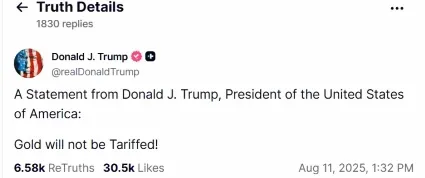
A Cloud Over the U.S. Bullion Market
In early August 2025, the bullion trade was jolted when U.S. Customs and Border Protection (CBP) reclassified common gold bar formats — specifically 1 kg and 100 oz bars — under tariff-eligible codes. The move ignited panic over potential 39% tariffs, prompting major Swiss refiners, America’s leading suppliers, to halt shipments. Gold prices surged to record highs before President Trump took to social media, promising that “gold will not be tariffed.”
The reassurance eased immediate fears, but the situation remains unresolved. Despite repeated White House promises, the Executive Order (EO) to formally confirm gold’s exemption has yet to appear. Nearly three weeks later, that gap is casting a long shadow over global bullion trade.
Why Is the Executive Order Delayed?
The administration has pledged to issue an EO that clears up “misinformation” about tariffs on gold bars. Yet as of late August, no directive has been filed with the Federal Register or listed on the official White House actions page.
The prolonged delay invites speculation:
- Legal complexity? Adjusting CBP’s tariff classifications may require extensive interagency review.
- Policy divisions? Differing views inside the administration could be slowing consensus.
- Negotiating tactic? The White House may be holding off deliberately to retain flexibility in wider trade talks.
Whatever the reason, the lack of clarity is becoming more consequential with each passing day.
Pressure on Supply Chains
Swiss refiners play an outsized role in supplying gold bars to the U.S. Their decision to pause shipments in response to tariff confusion underscores the fragility of global supply chains.
While COMEX inventories remain strong enough to cover immediate demand, this buffer cannot last indefinitely. Extended ambiguity risks creating bottlenecks that could ripple through bullion dealers, banks, and retail investors alike.
Market Sentiment and Investor Behavior
The initial tariff scare sent futures markets surging. Although Trump’s post cooled gold prices, sentiment remains fragile. With no EO in writing, traders are reacting to headlines with heightened sensitivity, generating bouts of volatility.
For long-term investors, the episode reinforces how policy clarity is as important as fundamentals in maintaining market stability. A single misclassification or delay can move billions in global capital within hours.
Price Outlook Amid Uncertainty
- Short-Term: Prices are elevated, supported by tariff concerns and ongoing uncertainty around Fed policy.
- Medium-Term: A swift EO release could allow prices to retrace slightly as supply chains normalize.
- Long-Term: The incident highlights systemic vulnerability — bullion markets will remain exposed to policy missteps and inconsistent classifications.
Why Clarity Matters Now
Gold is more than a commodity; it is a core financial asset and global reserve standard. The idea that its movement could be throttled by tariff confusion undermines confidence not only in bullion markets but also in U.S. trade reliability.
Until the EO is issued, the industry must operate in a gray zone — importing cautiously, hedging risk, and watching closely for official confirmation.
Looking Ahead
Three weeks after the CBP decision rattled markets, the missing Executive Order remains the elephant in the room. Every day of delay fuels speculation and keeps supply chains in limbo.
The bullion industry is left asking: Why hasn’t such a seemingly straightforward clarification been finalized?
Until words are turned into law, the U.S. gold market will remain in suspense — sustained by warehouse stockpiles, rattled by rumor, and waiting for clarity that is long overdue.
Other articles that may interest you:
Gold Tariff Relief Possible Under New Executive Order
Fort Knox Gold Audit: Will the Push for Transparency Finally Succeed?

